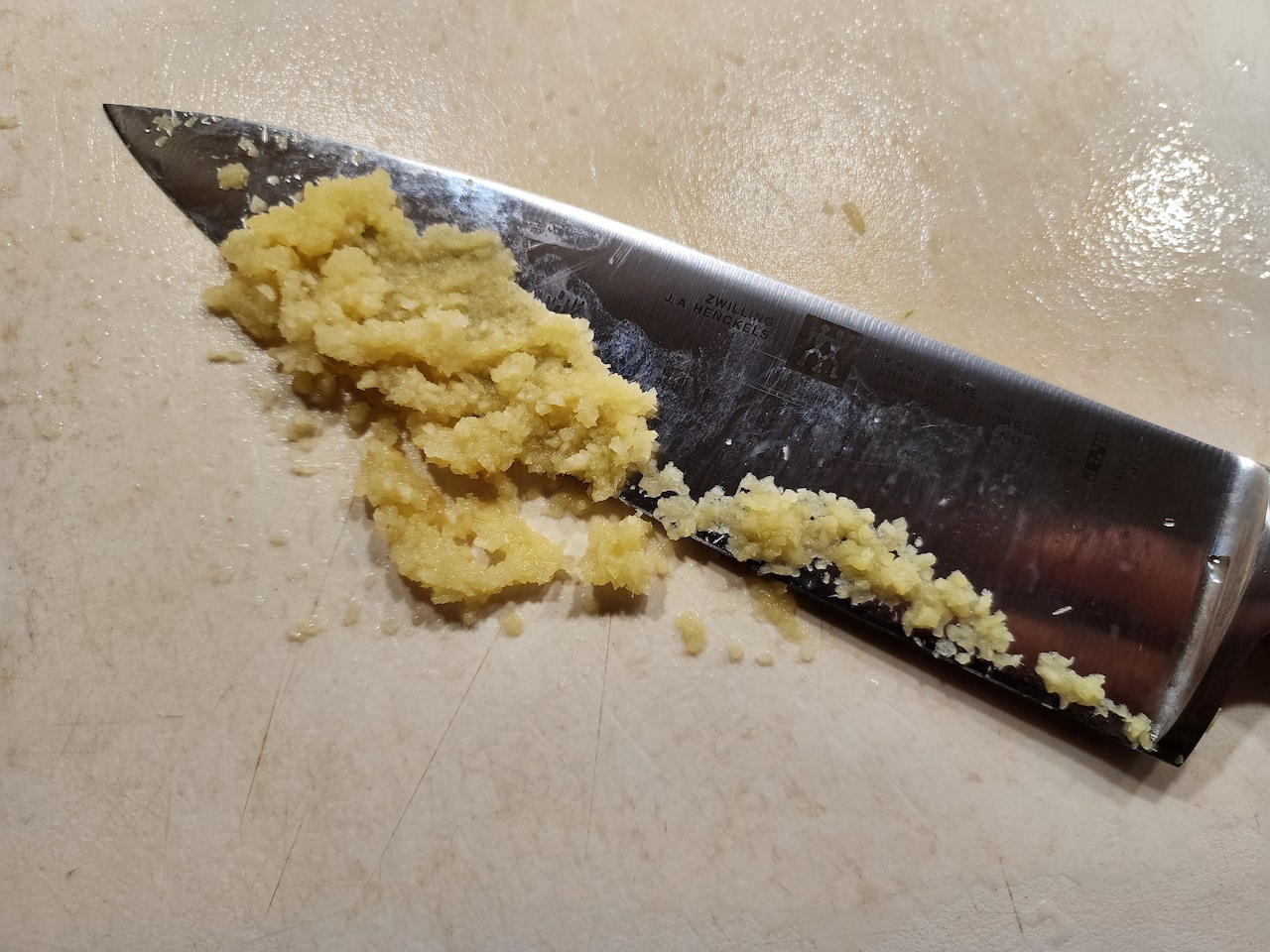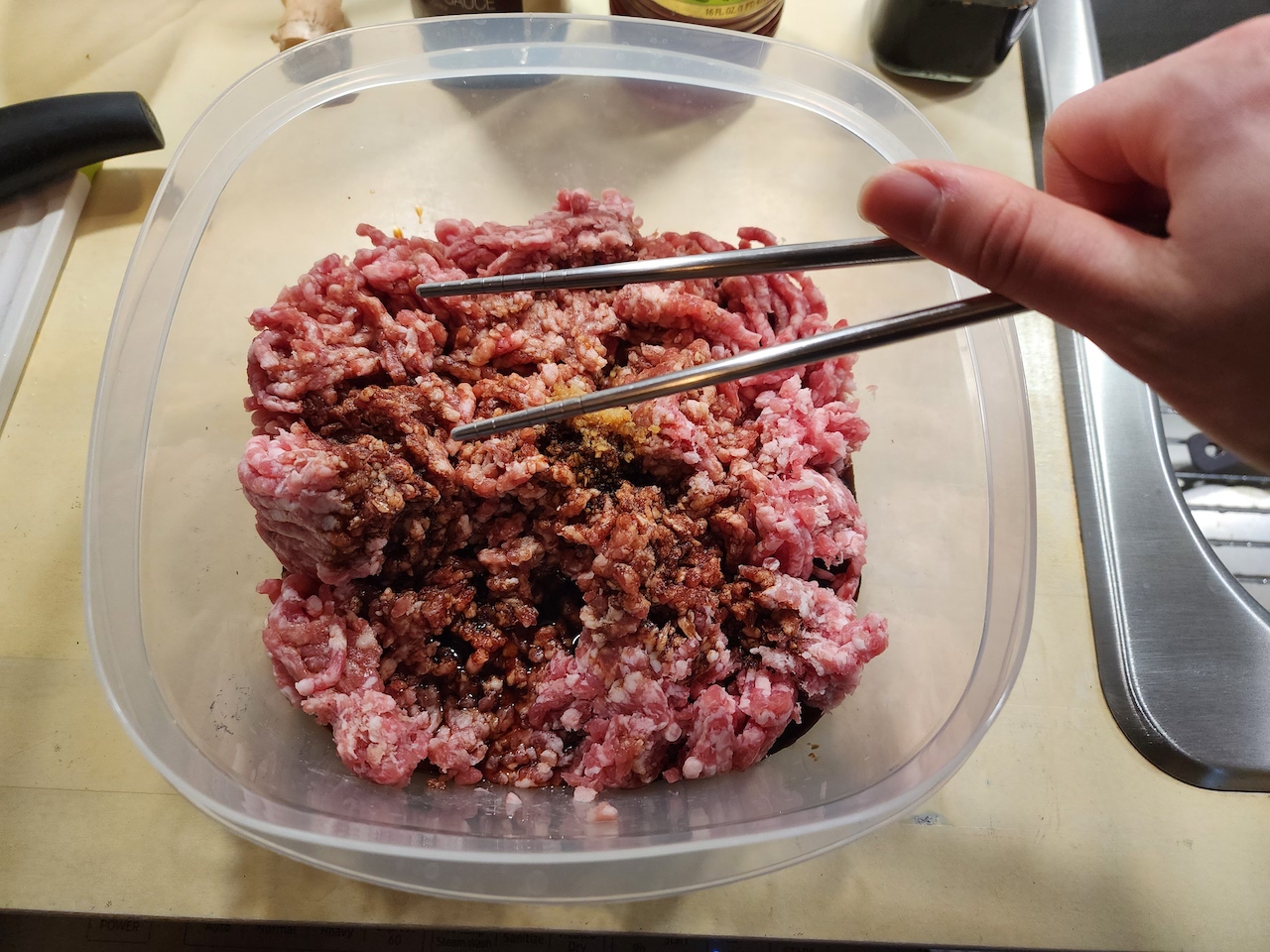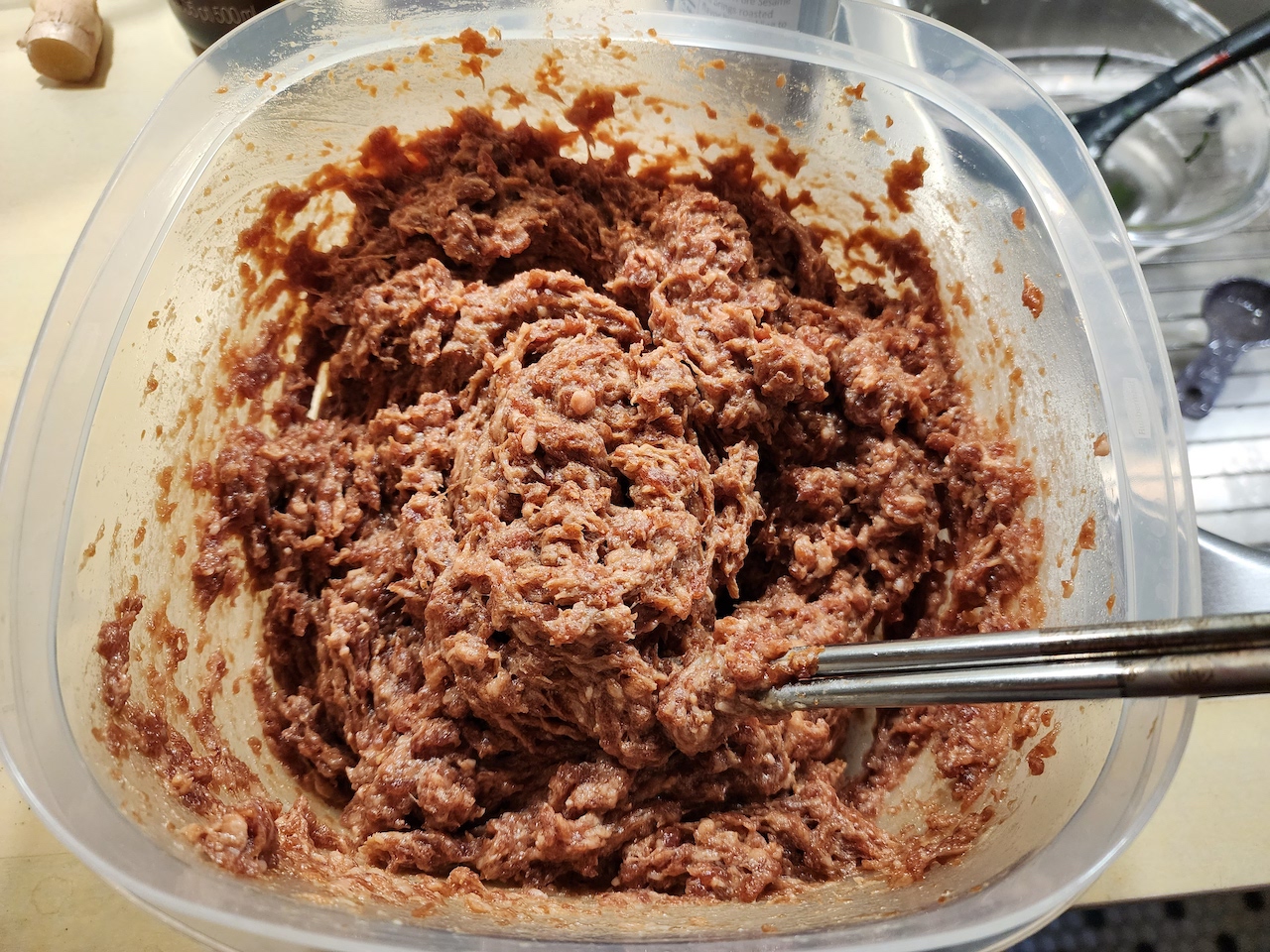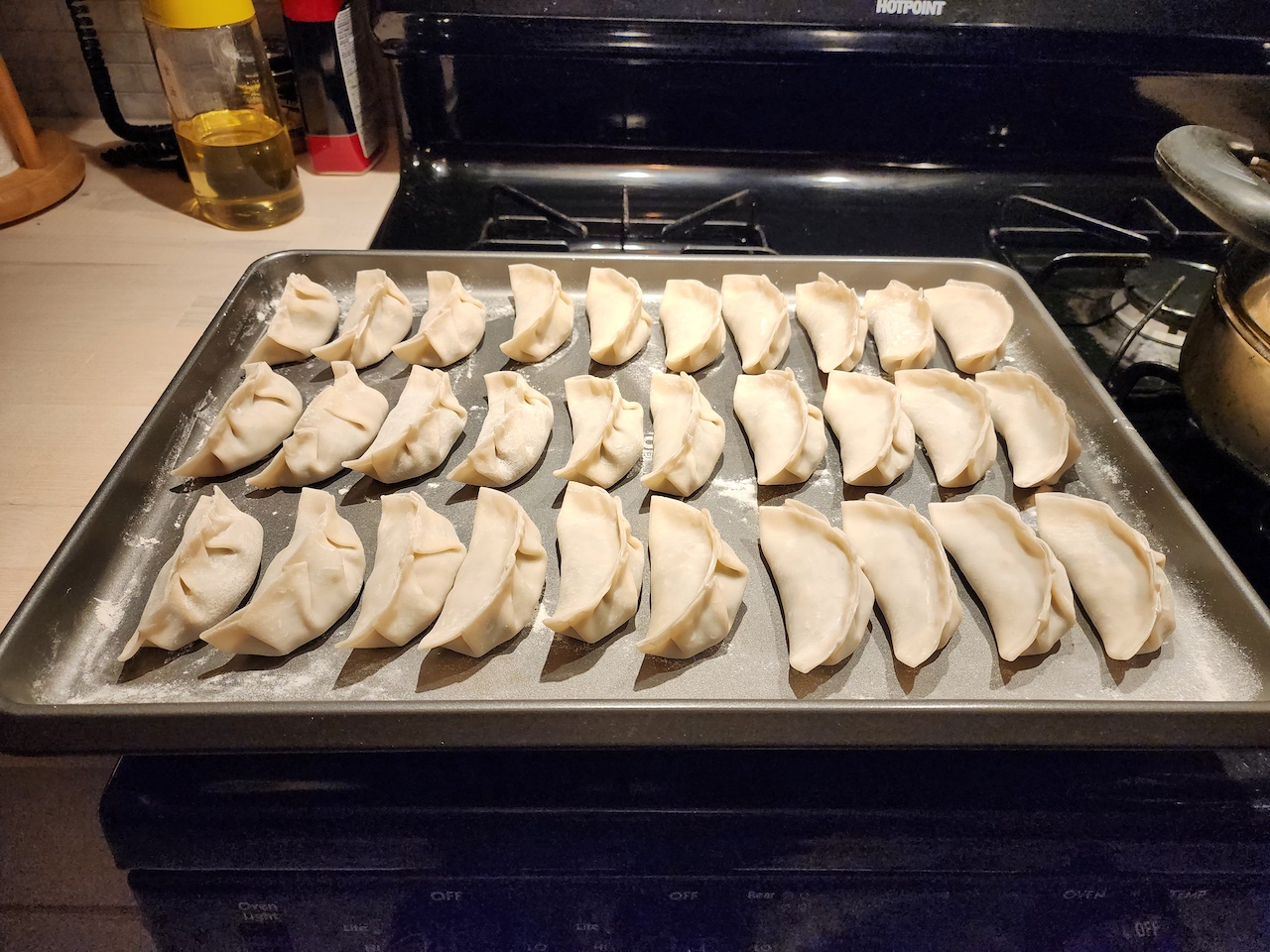Dumpling Recipe
Happy Lunar New Year, and 新年快乐恭喜发财! While there are many different traditions surrounding what to eat on New Year’s, ours is making dumplings.
Ingredients
This recipe makes roughly 75 fully filled dumplings (by my estimates most people eat 12-17 in a meal). I usually double this recipe for parties or to cook for a week. For ingredients that aren’t usually found at grocery stores, I have links to brand suggestions (but by all means use what you can find).
- 1 lb ground pork (This can be tricky to find in smaller grocery stores in Boston, as Star Market and smaller Target stores don’t stock this. There needs to be a decent amount of fat in the meat, and I found that Whole Foods ground pork is leaner and doesn’t taste as juicy. If you can go to a larger Target, their ground pork is perfect for this. Market Basket ground pork works well too. Honestly, use whatever you can get your hands on.)
- For pure spinach dumplings I use ~30-32 oz frozen cut spinach per pound of ground pork (either three 10 oz bags or one 32 oz bags, whatever unit is available in your store). For spinach and napa cabbage dumplings I use ~15-16 oz frozen cut spinach and ~1.5 lb napa cabbage (roughly half a large napa cabbage) per pound of ground pork. The amounts don’t need to be exact, but I find this gives me a good starting point.
- 1-2 tsp ginger (like, half of a section)
- 1-2 green onion stalks
- 2-3 packages of dumpling wrappers (I use Twin Marquis Shanghai-style wrappers; it’s better to have too many than too few, as your folding style will dictate how many wrappers you will use, and anything you don’t use can be re-frozen)
- 4 tbsp soy sauce (I use Kikkoman, but anything will do)
- 1 tbsp dark soy sauce (called “lao chou,” 老抽; I use this one from Lee Kum Kee; it’s mainly for color, so you could just substitute it with 1 tbsp soy sauce)
- 1 tbsp Shaoxing cooking wine (called “shao xing jiu,” 绍兴酒; any brand will work, I found this one at my Chinese grocery); personally I was able to discern whether this was missing or not
- 5 tbsp chicken broth (I just use broth reconstituted from cubes/paste)
- 1 tbsp sesame oil
- 2 tbsp vegetable oil
- Salt
- (optional) 1 tbsp oyster sauce (non-vegetarian and vegetarian options both work, normal people-sized bottles available in Asian supermarkets)
Recipe
Before starting out I’d highly recommend thawing the dumpling wrappers (if they were stored frozen, as they usually are at Asian grocery stores) and ground pork (if stored frozen) the night before. It’s particularly important for the ground pork because that takes the most time to thaw and overdoing the defrost cycle in the microwave will mess up the texture of the final product. Defrosting frozen dumpling wrappers in the microwave is also a recipe for disaster as the wrappers will fuse together and get soggy.
Making the Meat Paste
The first key component of a good dumpling filling is the springy meat texture, which comes from making a good meat paste. The meat paste can be prepared well in advance before a dumpling making session, or even frozen. Once the meat paste is mixed with vegetables, the filling usually can no longer be frozen (the resulting thawed filling will leak lots of water and can be extremely hard to work with). Begin by finely mincing the ginger and the green onion.

Add the minced ginger and green onion to the meat paste. Add the soy sauces, cooking wine, and optional oyster sauce, and add a teaspoon of salt. Begin mixing by splaying the chopsticks out as shown below. This will make it much easier to get the desirable texture.

Mix the ground pork and sauces together by stirring everything in a single direction (so choose clockwise or counterclockwise and stick with it). Once mixed well, add half of the chicken broth and continue mixing until the broth is absorbed, and then repeat the process for the other half of the broth. As you mix, you will notice that the mixture will develop fibers and become springy/harder to mix, which will get us the juicy texture we want. Then add the sesame and vegetable oils and continue mixing until the mixture “springs back at you” when poked. It should look something like the picture below. You want to see this through because it’s harder to achieve this texture once other vegetables are mixed in.

Finishing the Filling
The other component of a good filling is a good level of water content, which is controlled by adequately wringing out water from the added vegetables. Too much water in the vegetables will cause a soggy filling that is harder to wrap and falls apart when eaten. You can always add back water content (e.g. with extra chicken broth to make them tasty), but once the vegetables are added to the meat paste, you cannot take out the extra water content.
Frozen spinach can be easily thawed in the microwave or in warm water. Grab a handful and squeeze three to four times before adding to the meat paste. If using napa cabbage, separate the leaves and wash individually (dirt and bugs can sometimes get between the leaves), then mince. I wouldn’t mince any smaller than the picture below; larger bits will give a nice texture.

After mincing, place in a bowl and sprinkle a spoon of salt and mix. Let it sit for a couple of minutes to draw the water out, then wring two to three times before adding to the dumpling mixture. I would slowly add vegetable to the meat mixture and mix until you get a ratio that you like. For me, the picture below looks like a good ratio.

If the mixture feels a little dry (especially for spinach-only dumplings), add a tablespoon or two of vegetable oil and/or chicken broth.
Wrapping Dumplings
I don’t particularly have a good guide on how to wrap them (there are probably much better ones on YouTube) but here are some tips:
- It’s better to underfill than overfill
- Make sure to close the seams firmly at the edges
- The wrapped appearance doesn’t matter too much since they’ll become wrinkly when cooked and ultimately all taste the same
- If you’re having trouble with poor quality dumpling wrappers that are dry, hard, or break easily, try taking a small stack and dipping the outside rim in water; as they sit while you wrap the water will soften the outside rim, making it easier to close the dumplings

Cooking
While there are ways to fry fresh dumplings, my recommendation is to eat them boiled (called “shui jiao,” 水饺) on the first day. They will be easier to store as leftovers this way. The leftover boiled dumplings can then be easily fried with vegetable in a fry pan.
Bring a large pot of water to a rolling boil and add up to 25 dumplings. Mix the water around to make sure no dumplings stick to the bottom. Let the water boil and then add a cup of cold water. Wait until the water boils over again before serving.
Sauce Recommendations
Here are a couple of sauce recommendations that will complete your dumpling meal. Feel free to mix sauces as you please.
- Lao Gan Ma Fried Chili in Oil: this is a very well known chili oil sauce. I’m very particular about liking the version with the green stripe as opposed to the red stripe version as it contains peanuts which add a nice crunchy texture and also has crunchier chili flakes.
- Hai Tian (Haday) Premium Yi Pi Xian Soy Sauce: a really aromatic and savory soy sauce that works great for dipping. My favorite with fried dumplings.
- Jin Shan Zhenjiang Vinegar: tangy and sharp, good contrast.





